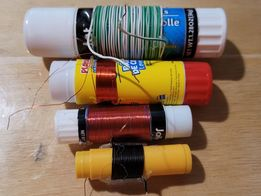Some of Paul's coils:
Podcasting since 2005! Listen to Latest SolderSmoke
Sunday, October 9, 2022
Paul Clark's Dollar Store PTOs made with Glue Sticks or Chap Sticks
Friday, October 7, 2022
How the Diode Ring Multiplies by 1 and -1 -- "The Secrets of the Diode Ring" -- Plus another Bandsweep with the DC RX
Thursday, October 6, 2022
How to Tap an Aluminum Heat Sink: Pete Juliano Shares Tribal Knowledge
Adding a Diode Ring to the Direct Conversion Receiver, And How the Diode Ring Works
Tuesday, October 4, 2022
Tim Hunkin's "The Radio Set" Drawing, and The Secret Life of the Radio (Remastered)
Thanks Tim!
The Workshop and Bench of the QRP Home Builder, Todd VE7BPO
Sunday, October 2, 2022
Update on the Direct Conversion Receiver -- Now only 4 transistors
Friday, September 30, 2022
Sticker News (from Holland)
https://www.vice.com/nl/article/wxnpp5/wie-zijn-de-mensen-die-overal-stickers-plakken
I shared with our Solder-Sticker Community these thoughts:
Really cool Lex. This reminds me that we need more stickers. And maybe a new design. The IBEW thing confuses Americans -- here it looks like a labor union thing.
Bandsweep with the New Homebrew 40 meter Direct Conversion Receiver
-- The mixer is singly balanced using one trifilar toroid and two diodes. We have found out that even with these three simple devices, there is significant variation in how people connect them to VFO, RF in and audio out. I think we have found the best way to do this: Be sure to put the VFO on the primary of the transformer, and let this signal turn the diodes on and off.
-- For the AF amplification, I have one FET, followed by two BJTs. I have a small audio transformer between the speaker and the final AF amp. There is plenty of audio.
You may wonder why, after all the SSB superhet transceivers, I am building a simple Direct Conversion receiver. Well, we hope to help a bunch of high school kids build one, so we need to be really familiar with how it works. And I find that as simple as it is, there is still a lot to learn in a project like this.
Thursday, September 29, 2022
A Bout of Direct Conversion-ism in Northern Virginia -- DC Receivers Under Construction
Tuesday, September 27, 2022
SolderSmoke Podcast #130 Feb 5, 2011 Trivia Questions! Recorded on a D-104! Heroic efforts to Suppresssss Ssssibilant SSSSs
February 5, 2011
For many reasons, this is a pretty amazing SolderSmoke episode. We presented some radio-electronic trivia questions. This is the one where I used an Astatic D-104 microphone to record the show. I even describe putting Starburst candies, Chicklet gum, and even Duct Tape on my teeth in an effort to get rid of the sibilant S problem. This was truly heroic podcasting my friends! There is lots of other great stuff in this one. Maria arrives in the shack with both Tyson the cat and Cappuccio the dog! Lots of space talk. The story of Grote Reber's name. Much more: Some important trivia questions (answers will be given in the podcast): What is the connection between radio amateur (and pioneer radio astronomer) Grote Reber and world famous astronomer Edwin Hubble? In the world of radio-controlled helicopters, what is "TBE"? In Britain they have radio "rallies," but at one time they had hamfests." When did this happen? Only one terrain feature on Venus is named for a man. He is man of radio. Who is he? What music did Neil Armstrong listen to on his way to the moon? Plus: -- The Air and Space Museums -- Our music -- The SolderSmoke D-104 -- NASA asks for our help -- Telescope repairs -- A BFO for the Trans-O -- Back on Echolink MAILBAG! Please send reports on the D-104 audio!Monday, September 26, 2022
Open Circuits: Cutting Open Components for a Look inside -- First Chapter Free
Bob KD4EBM sent me this:
https://nostarch.com/download/OpenCircuits_Chapter1.pdf
Many of our favorite parts are dissected in that chapter. The innards of a ceramic disc capacitor, for example, are shown above.
Thanks Bob!







.png)































